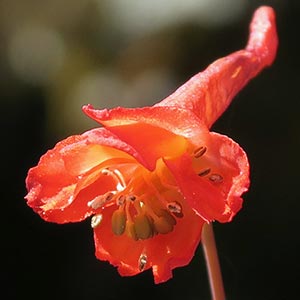Delphinium nudicaule
Delphinium inopinum
canyon delphinium, canyon larkspur, orange larkspur, red larkspur, red or orange larkspur, scarlet larkspur
unexpected larkspur
(15-)20-50(-125) cm;
base reddish, glabrous.
70-110(-150) cm;
base reddish or not, glabrous, often glaucous.
blade round to pentagonal, 2-6 × 3-10 cm; ultimate lobes 3-12, width 5-40 mm (basal), 2-20 mm (cauline).
blade ± pentagonal, 1-5 × 1.5-7 cm, glabrous; ultimate lobes 3-9, width 5-28 mm (basal), 3-18 mm (cauline).
5-20(-69)-flowered;
pedicel (1.5-)2-6(-8) cm, glabrous to glandular-pubescent;
bracteoles 14-20(-30) mm from flowers, green to red, linear, 2-4(-9) mm, glabrous to puberulent.
20-35(-51)-flowered, usually dense;
pedicel 0.3-1.5(-2.5) cm, glabrous;
bracteoles 2-4 mm from flowers, green, linear, 1-2(-4) mm, nearly glabrous.
sepals scarlet to reddish orange, rarely dull yellow, glabrous, lateral sepals forward-pointing to form pseudotube, (6-)8-13(-16) × 3-6 mm, spurs straight, slightly ascending, (12-)18-27(-34) mm;
lower petal blades elevated, exposing stamens, 2-3 mm, clefts 0.5-1 mm;
hairs sparse, evenly dispersed, yellow.
sepals white to light blue, glabrous, lateral sepals spreading to forward pointing, 8-12 × 3-5 mm, spurs straight to gently upcurved, ascending 30-60° above horizontal, 9-12 mm;
lower petal blades slightly elevated, ± exposing stamens, 3-5 mm, clefts 1-2 mm;
hairs centered, densest near base of cleft, white.
13-26 mm, 3.5-4.5 times longer than wide, glabrous.
12-20 mm, 2.6-4 times longer than wide, glabrous.
unwinged or sometimes slightly wing-margined;
seed coat cells with surfaces smooth.
wing-margined;
seed coat cells surfaces smooth.
= 16.
Delphinium nudicaule
Delphinium inopinum
Delphinium nudicaule hybridizes with most other taxa of Delphinium that it encounters. Apparent hybrids involving D. nudicaule, and seen by the author (either afield or as specimens), include D. andersonii, D. antoninum, D. decorum, D. luteum, D. nuttallianum, D. patens, and D. trolliifolium. In addition, garden-grown plants have been hybridized with D. cardinale, D. elatum, D. menziesii, D. parishii, D. penardii, D. tatsienense Franchet, D. triste Fischer ex de Candolle, and D. uliginosum; D. nudicaule does not naturally occur with these species. Delphinium nudicaule is one of the earliest larkspurs to flower in any given locality. Douglas's type collection of D. nudicaule represents plants (synonyms D. sarcophyllum Hooker & Arnott and D. peltatum Hooker, an invalid name) grown under very moist conditions, probably quite near the ocean. The type specimen of D. armeniacum A. Heller represents plants grown under unusually dry conditions.
The Mendocino Indians consider Delphinium nudicaule a narcotic (D. E. Moerman 1986).
(Discussion copyrighted by Flora of North America; reprinted with permission.)
Delphinium inopinum is apparently endemic to a white metamorphic rock substrate in the Piute Mountains and southern Sierra Nevada. It is not known to hybridize with any other species, although D. patens subsp. montanum has been collected (when both were flowering) within 1 km of D. inopinum and probably occurs much closer. Delphinium inopinum is often confused with D. parishii subsp. pallidum and superficially resembles some white-flowered individuals of D. hansenii, as well as D. gypsophilum and D. hesperium subsp. pallescens. The massive roots with prominent buds readily distinguish D. inopinum from all of these. In addition, the pubescence found on D. hansenii will separate it from the glabrous D. inopinum. Leaves are rarely seen at anthesis near the base of the stem in D. hesperium subsp. pallescens; they are present in D. inopinum.
(Discussion copyrighted by Flora of North America; reprinted with permission.)


